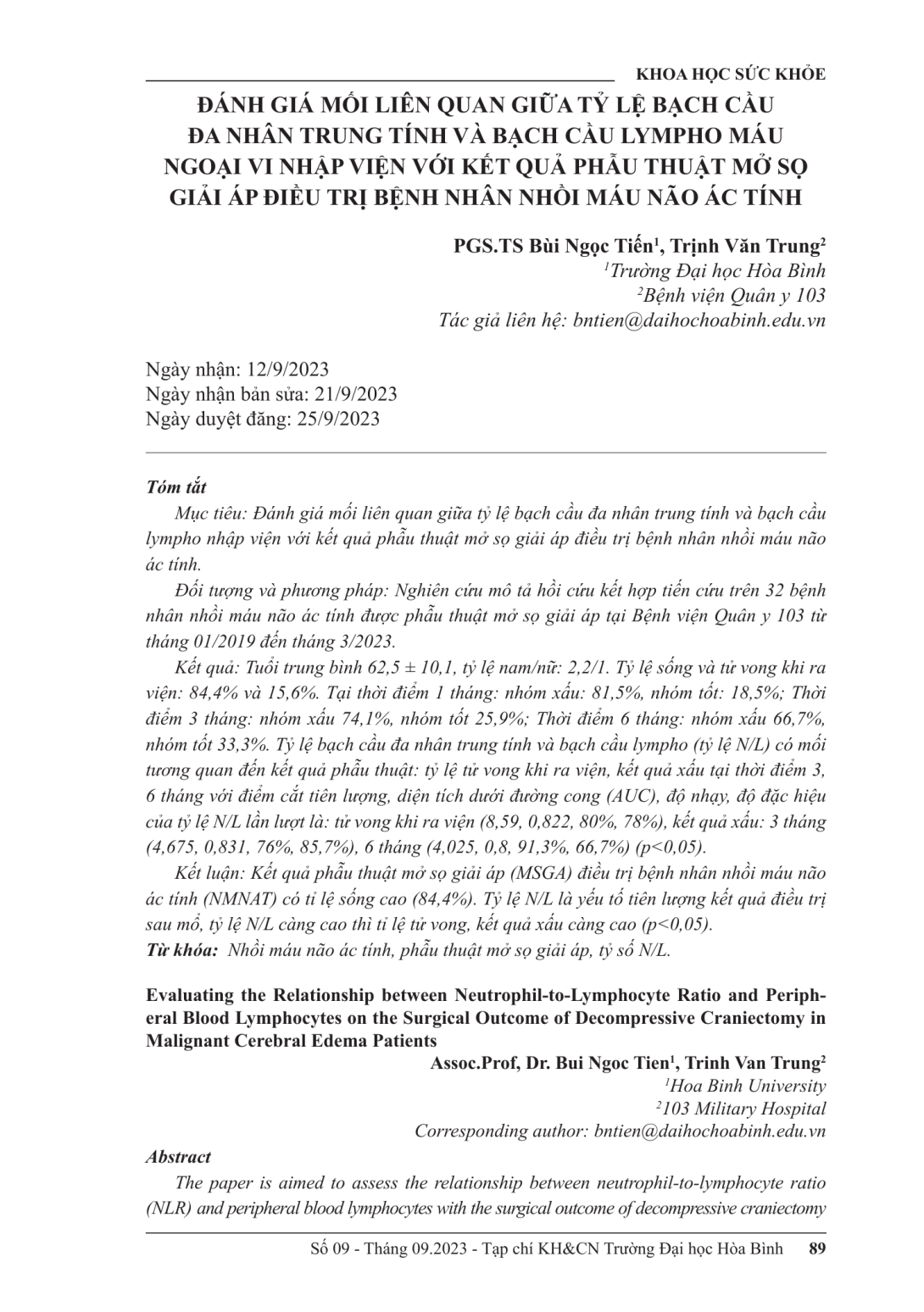
Đánh giá mối liên quan giữa tỷ lệ bạch cầu đa nhân trung tính và bạch cầu lympho nhập viện với kết quả phẫu thuật mở sọ giải áp điều trị bệnh nhân nhồi máu não ác tính. Đối tượng và phương pháp: Nghiên cứu mô tả hồi cứu kết hợp tiến cứu trên 32 bệnh nhân nhồi máu não ác tính được phẫu thuật mở sọ giải áp tại Bệnh viện Quân y 103 từ tháng 01/2019 đến tháng 3/2023. Kết quả: Tuổi trung bình 62,5 ± 10,1, tỷ lệ nam/nữ: 2,2/1. Tỷ lệ sống và tử vong khi ra viện: 84,4% và 15,6%. Tại thời điểm 1 tháng: nhóm xấu: 81,5%, nhóm tốt: 18,5%; Thời điểm 3 tháng: nhóm xấu 74,1%, nhóm tốt 25,9%; Thời điểm 6 tháng: nhóm xấu 66,7%, nhóm tốt 33,3%. Tỷ lệ bạch cầu đa nhân trung tính và bạch cầu lympho (tỷ lệ N/L) có mối tương quan đến kết quả phẫu thuật: tỷ lệ tử vong khi ra viện, kết quả xấu tại thời điểm 3, 6 tháng với điểm cắt tiên lượng, diện tích dưới đường cong (AUC), độ nhạy, độ đặc hiệu của tỷ lệ N/L lần lượt là: tử vong khi ra viện (8,59, 0,822, 80%, 78%), kết quả xấu: 3 tháng (4,675, 0,831, 76%, 85,7%), 6 tháng (4,025, 0,8, 91,3%, 66,7%) (p<0,05). Kết luận: Kết quả phẫu thuật mở sọ giải áp (MSGA) điều trị bệnh nhân nhồi máu não ác tính (NMNAT) có tỉ lệ sống cao (84,4%). Tỷ lệ N/L là yếu tố tiên lượng kết quả điều trị sau mổ, tỷ lệ N/L càng cao thì tỉ lệ tử vong, kết quả xấu càng cao (p<0,05).
The paper is aimed to assess the relationship between neutrophil-to-lymphocyte ratio (NLR) and peripheral blood lymphocytes with the surgical outcome of decompressive craniectomy in patients with malignant cerebral edema. Its subjects and the methods applied focus on a retrospective descriptive study combined with prospective research was conducted on 32 patients who underwent decompressive craniectomy for malignant cerebral edema at Military Hospital 103 from January 2019 to March 2023. The results are the mean age was 62.5 ± 10.1, with a male-to-female ratio of 2.2:1. The in-hospital survival rate was 84.4%, with a mortality rate of 15.6%. At the 1-month follow-up, the poor outcome group accounted for 81.5% while the good outcome group accounted for 18.5%. At the 3-month follow-up, the poor outcome group accounted for 74.1% while the good outcome group accounted for 25.9%. At the 6-month follow-up, the poor outcome group accounted for 66.7% while the good outcome group accounted for 33.3%. The neutrophil-to-lymphocyte ratio (NLR) showed correlation with surgical outcomes, including in-hospital mortality and poor outcomes at 3 and 6 months, with the cutoff points, area under the curve (AUC), sensitivity, and specificity of NLR as follows: in-hospital mortality (8.59, 0.822, 80%, 78%), poor outcome at 3 months (4.675, 0.831, 76%, 85.7%), poor outcome at 6 months (4.025, 0.8, 91.3%, 66.7%) (p<0.05). In conclusion, decompressive craniectomy had a high survival rate (84.4%) in treating patients with malignant cerebral edema. The NLR was a prognostic factor for surgical outcomes, with higher NLR associated with increased mortality and poorer outcomes (p<0.05).
- Đăng nhập để gửi ý kiến
